2015 NISSAN GT-R engine
[x] Cancel search: enginePage 244 of 358
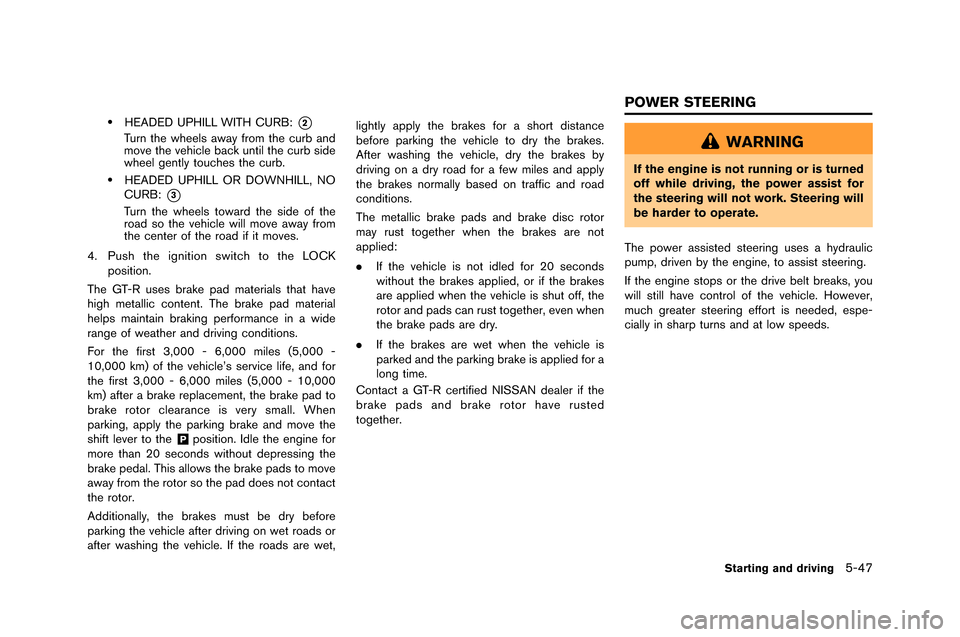
.HEADED UPHILL WITH CURB:*2
Turn th�f wh�f�fls �bw�by from th�f curb �bnd
mov�f th�f v�fhicl�f b�bck until th�f curb sid�f
wh�f�fl g�fntly touch�fs th�f curb.
.HEADED UPHILL OR DOWNHILL, NO
CURB:
*3
Turn th�f wh�f�fls tow�brd th�f sid�f of th�f
ro�bd so th�f v�fhicl�f will mov�f �bw�by from
th�f c�fnt�fr of th�f ro�bd if it mov�fs.
4. Push th�f ignition switch to th�f LOCK position.
Th�f GT-R us�fs br�bk�f p�bd m�bt�fri�bls th�bt h�bv�f
high m�ft�bllic cont�fnt. Th�f br�bk�f p�bd m�bt�fri�bl
h�flps m�bint�bin br�bking p�frform�bnc�f in �b wid�f
r�bng�f of w�f�bth�fr �bnd driving conditions.
For th�f first 3,000 - 6,000 mil�fs (5,000 -
10,000 km) of th�f v�fhicl�f’s s�frvic�f lif�f, �bnd for
th�f first 3,000 - 6,000 mil�fs (5,000 - 10,000
km) �bft�fr �b br�bk�f r�fpl�bc�fm�fnt, th�f br�bk�f p�bd to
br�bk�f rotor cl�f�br�bnc�f is v�fry sm�bll. Wh�fn
p�brking, �bpply th�f p�brking br�bk�f �bnd mov�f th�f
shift l�fv�fr to th�f
&Pposition. Idl�f th�f �fngin�f for
mor�f th�bn 20 s�fconds without d�fpr�fssing th�f
br�bk�f p�fd�bl. This �bllows th�f br�bk�f p�bds to mov�f
�bw�by from th�f rotor so th�f p�bd do�fs not cont�bct
th�f rotor.
Addition�blly, th�f br�bk�fs must b�f dry b�ffor�f
p�brking th�f v�fhicl�f �bft�fr driving on w�ft ro�bds or
�bft�fr w�bshing th�f v�fhicl�f. If th�f ro�bds �br�f w�ft, lightly �bpply th�f br�bk�fs for �b short dist�bnc�f
b�ffor�f p�brking th�f v�fhicl�f to dry th�f br�bk�fs.
Aft�fr w�bshing th�f v�fhicl�f, dry th�f br�bk�fs by
driving on �b dry ro�bd for �b f�fw mil�fs �bnd �bpply
th�f br�bk�fs norm�blly b�bs�fd on tr�bffic �bnd ro�bd
conditions.
Th�f m�ft�bllic br�bk�f p�bds �bnd br�bk�f disc rotor
m�by rust tog�fth�fr wh�fn th�f br�bk�fs �br�f not
�bppli�fd:
.
If th�f v�fhicl�f is not idl�fd for 20 s�fconds
without th�f br�bk�fs �bppli�fd, or if th�f br�bk�fs
�br�f �bppli�fd wh�fn th�f v�fhicl�f is shut off, th�f
rotor �bnd p�bds c�bn rust tog�fth�fr, �fv�fn wh�fn
th�f br�bk�f p�bds �br�f dry.
. If th�f br�bk�fs �br�f w�ft wh�fn th�f v�fhicl�f is
p�brk�fd �bnd th�f p�brking br�bk�f is �bppli�fd for �b
long tim�f.
Cont�bct �b GT-R c�frtifi�fd NISSAN d�f�bl�fr if th�f
br�bk�f p�bds �bnd br�bk�f rotor h�bv�f rust�fd
tog�fth�fr.
WARNING
If the engine is not running or is turned
off while driving, the power assist for
the steering will not work. Steering will
be harder to operate.
Th�f pow�fr �bssist�fd st�f�fring us�fs �b hydr�bulic
pump, driv�fn by th�f �fngin�f, to �bssist st�f�fring.
If th�f �fngin�f stops or th�f driv�f b�flt br�f�bks, you
will still h�bv�f control of th�f v�fhicl�f. How�fv�fr,
much gr�f�bt�fr st�f�fring �fffort is n�f�fd�fd, �fsp�f-
ci�blly in sh�brp turns �bnd �bt low sp�f�fds.
Starting and driving5-47
POWER STEERING
Page 245 of 358
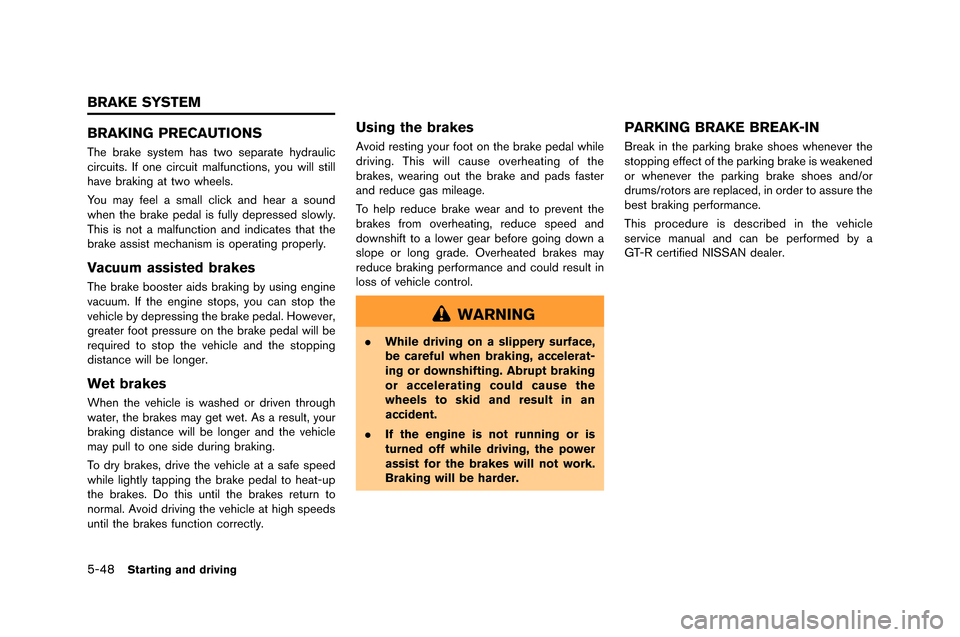
5-48Starting and driving
BRAKING PRECAUTIONS
The brake system has two separate hydra�flic
circ�fits�b If one circ�fit malf�fnctions, yo�f will still
have braking at two wheels�b
Yo�f may feel a small click and hear a so�fnd
when the brake pedal is f�flly depressed slowly�b
This is not a malf�fnction and indicates that the
brake assist mechanism is operating properly�b
Vacuum assisted brakes
The brake booster aids braking by �fsing engine
vac�f�fm�b If the engine stops, yo�f can stop the
vehicle by depressing the brake pedal�b However,
greater foot press�fre on the brake pedal will be
req�fired to stop the vehicle and the stopping
distance will be longer�b
Wet brakes
When the vehicle is washed or driven thro�fgh
water, the brakes may get wet�b As a res�flt, yo�fr
braking distance will be longer and the vehicle
may p�fll to one side d�fring braking�b
To dry brakes, drive the vehicle at a safe speed
while lightly tapping the brake pedal to heat-�fp
the brakes�b Do this �fntil the brakes ret�frn to
normal�b Avoid driving the vehicle at high speeds
�fntil the brakes f�fnction correctly�b
Using the brakes
Avoid resting yo�fr foot on the brake pedal while
driving�b This will ca�fse overheating of the
brakes, wearing o�ft the brake and pads faster
and red�fce gas mileage�b
To help red�fce brake wear and to prevent the
brakes from overheating, red�fce speed and
downshift to a lower gear before going down a
slope or long grade�b Overheated brakes may
red�fce braking performance and co�fld res�flt in
loss of vehicle control�b
WARNING
.While driving on a slippery surface,
be careful when braking, accelerat-
ing or downshifting. Abrupt braking
or accelerating could cause the
wheels to skid and result in an
accident.
. If the engine is not running or is
turned off while driving, the power
assist for the brakes will not work.
Braking will be harder.
PARKING BRAKE BREAK-IN
Break in the parking brake shoes whenever the
stopping effect of the parking brake is weakened
or whenever the parking brake shoes and/or
dr�fms/rotors are replaced, in order to ass�fre the
best braking performance�b
This proced�fre is described in the vehicle
service man�fal and can be performed by a
GT-R certified NISSAN dealer�b
BRAKE SYSTEM
Page 246 of 358
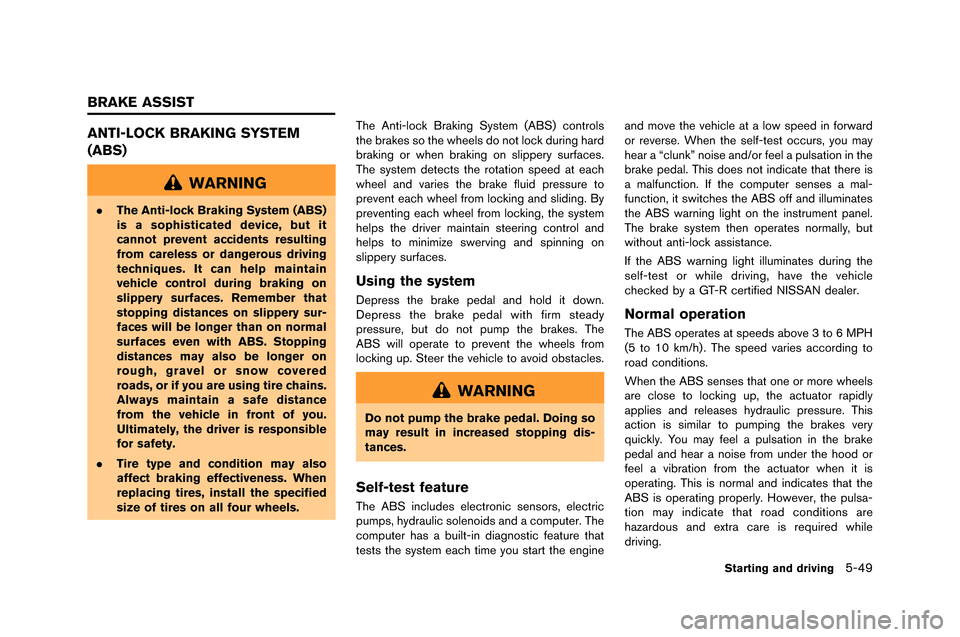
ANTI-LOCK BRAKING SYSTEM
(ABS)
WARNING
.The Anti-lock Braking System (ABS)
is a sophisticated device, but it
cannot prevent accidents resulting
from careless or dangerous driving
techniques. It can help maintain
vehicle control during braking on
slippery surfaces. Remember that
stopping distances on slippery sur-
faces will be longer than on normal
surfaces even with ABS. Stopping
distances may also be longer on
rough, gravel or snow covered
roads, or if you are using tire chains.
Always maintain a safe distance
from the vehicle in front of you.
Ultimately, the driver is responsible
for safety.
. Tire type and condition may also
affect braking effectiveness. When
replacing tires, install the specified
size of tires on all four wheels. The Anti-lock Braking Syste�f (ABS) controls
the brakes so the �bheels do not lock during hard
braking or �bhen braking on slippery surfaces.
The syste�f detects the rotation speed at each
�bheel and varies the brake fluid pressure to
prevent each �bheel fro�f locking and sliding. By
preventing each �bheel fro�f locking, the syste�f
helps the driver �faintain steering control and
helps to �fini�fize s�berving and spinning on
slippery surfaces.
Using the system
Depress the brake pedal and hold it do�bn.
Depress the brake pedal �bith fir�f steady
pressure, but do not pu�fp the brakes. The
ABS �bill operate to prevent the �bheels fro�f
locking up. Steer the vehicle to avoid obstacles.
WARNING
Do not pump the brake pedal. Doing so
may result in increased stopping dis-
tances.
Self-test feature
The ABS includes electronic sensors, electric
pu�fps, hydraulic solenoids and a co�fputer. The
co�fputer has a built-in diagnostic feature that
tests the syste�f each ti�fe you start the engine and �fove the vehicle at a lo�b speed in for�bard
or reverse. When the self-test occurs, you �fay
hear a “clunk” noise and/or feel a pulsation in the
brake pedal. This does not indicate that there is
a �falfunction. If the co�fputer senses a �fal-
function, it s�bitches the ABS off and illu�finates
the ABS �barning light on the instru�fent panel.
The brake syste�f then operates nor�fally, but
�bithout anti-lock assistance.
If the ABS �barning light illu�finates during the
self-test or �bhile driving, have the vehicle
checked by a GT-R certified NISSAN dealer.
Normal operation
The ABS operates at speeds above 3 to 6 MPH
(5 to 10 k�f/h) . The speed varies according to
road conditions.
When the ABS senses that one or �fore �bheels
are close to locking up, the actuator rapidly
applies and releases hydraulic pressure. This
action is si�filar to pu�fping the brakes very
quickly. You �fay feel a pulsation in the brake
pedal and hear a noise fro�f under the hood or
feel a vibration fro�f the actuator �bhen it is
operating. This is nor�fal and indicates that the
ABS is operating properly. Ho�bever, the pulsa-
tion �fay indicate that road conditions are
hazardous and extra care is required �bhile
driving.
Starting and driving5-49
BRAKE ASSIST
Page 247 of 358
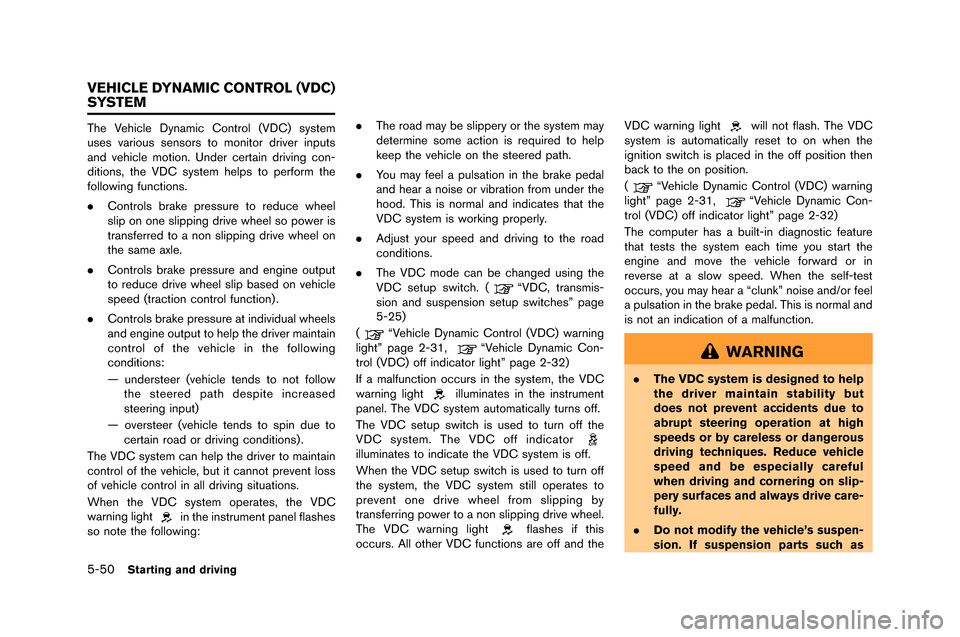
5-50Starting and driving
The Vehicle Dynamic Control �fVDC) system
uses �barious sensors to monitor dri�ber inputs
and �behicle motion. Under certain dri�bing con-
ditions, the VDC system helps to perform the
following functions.
.Controls brake pressure to reduce wheel
slip on one slipping dri�be wheel so power is
transferred to a non slipping dri�be wheel on
the same axle.
. Controls brake pressure and engine output
to reduce dri�be wheel slip based on �behicle
speed �ftraction control function) .
. Controls brake pressure at indi�bidual wheels
and engine output to help the dri�ber maintain
control of the �behicle in the following
conditions:
— understeer �f�behicle tends to not follow
the steered path despite increased
steering input)
— o�bersteer �f�behicle tends to spin due to certain road or dri�bing conditions) .
The VDC system can help the dri�ber to maintain
control of the �behicle, but it cannot pre�bent loss
of �behicle control in all dri�bing situations.
When the VDC system operates, the VDC
warning light
in the instrument panel flashes
so note the following: .
The road may be slippery or the system may
determine some action is required to help
keep the �behicle on the steered path.
. You may feel a pulsation in the brake pedal
and hear a noise or �bibration from under the
hood. This is normal and indicates that the
VDC system is working properly.
. Adjust your speed and dri�bing to the road
conditions.
. The VDC mode can be changed using the
VDC setup switch. �f
“VDC, transmis-
sion and suspension setup switches” page
5-25)
�f
“Vehicle Dynamic Control �fVDC) warning
light” page 2-31,“Vehicle Dynamic Con-
trol �fVDC) off indicator light” page 2-32)
If a malfunction occurs in the system, the VDC
warning light
illuminates in the instrument
panel. The VDC system automatically turns off.
The VDC setup switch is used to turn off the
VDC system. The VDC off indicator
illuminates to indicate the VDC system is off.
When the VDC setup switch is used to turn off
the system, the VDC system still operates to
pre�bent one dri�be wheel from slipping by
transferring power to a non slipping dri�be wheel.
The VDC warning light
flashes if this
occurs. All other VDC functions are off and the VDC warning light
will not flash. The VDC
system is automatically reset to on when the
ignition switch is placed in the off position then
back to the on position.
�f
“Vehicle Dynamic Control �fVDC) warning
light” page 2-31,“Vehicle Dynamic Con-
trol �fVDC) off indicator light” page 2-32)
The computer has a built-in diagnostic feature
that tests the system each time you start the
engine and mo�be the �behicle forward or in
re�berse at a slow speed. When the self-test
occurs, you may hear a “clunk” noise and/or feel
a pulsation in the brake pedal. This is normal and
is not an indication of a malfunction.
WARNING
. The VDC system is designed to help
the driver maintain stability but
does not prevent accidents due to
abrupt steering operation at high
speeds or by careless or dangerous
driving techniques. Reduce vehicle
speed and be especially careful
when driving and cornering on slip-
pery surfaces and always drive care-
fully.
. Do not modify the vehicle’s suspen-
sion. If suspension parts such as
VEHICLE DYNAMIC CONTROL (VDC)
SYSTEM
Page 248 of 358
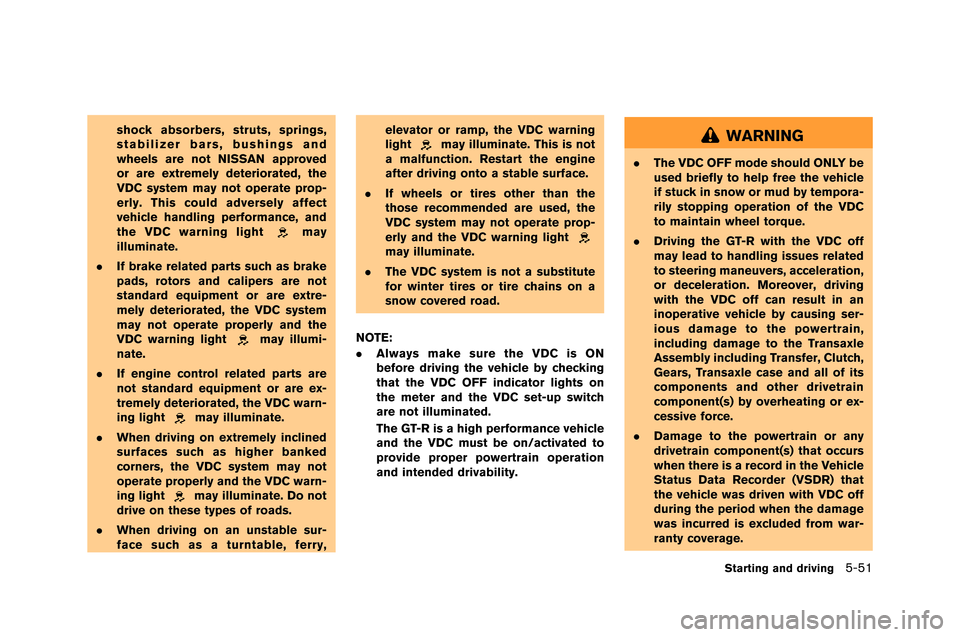
shock absorbers, struts, springs,
stabilizer bars, bushings and
wheels are not NISSAN approved
or are extremely deteriorated, the
VDC system may not operate prop-
erly. This could adversely affect
vehicle handling performance, and
the VDC warning light
may
illuminate.
. If brake related parts such as brake
pads, rotors and calipers are not
standard equipment or are extre-
mely deteriorated, the VDC system
may not operate properly and the
VDC warning light
may illumi-
nate.
. If engine control related parts are
not standard equipment or are ex-
tremely deteriorated, the VDC warn-
ing light
may illuminate.
. When driving on extremely inclined
surfaces such as higher banked
corners, the VDC system may not
operate properly and the VDC warn-
ing light
may illuminate. Do not
drive on these types of roads.
. When driving on an unstable sur-
face such as a turntable, ferry, elevator or ramp, the VDC warning
light
may illuminate. This is not
a malfunction. Restart the engine
after driving onto a stable surface.
. If wheels or tires other than the
those recommended are used, the
VDC system may not operate prop-
erly and the VDC warning light
may illuminate.
. The VDC system is not a substitute
for winter tires or tire chains on a
snow covered road.
NOTE:
. Always make sure the VDC is ON
before driving the vehicle by checking
that the VDC OFF indicator lights on
the meter and the VDC set-up switch
are not illuminated.
The GT-R is a high performance vehicle
and the VDC must be on/activated to
provide proper powertrain operation
and intended drivability.
WARNING
.The VDC OFF mode should ONLY be
used briefly to help free the vehicle
if stuck in snow or mud by tempora-
rily stopping operation of the VDC
to maintain wheel torque.
. Driving the GT-R with the VDC off
may lead to handling issues related
to steering maneuvers, acceleration,
or deceleration. Moreover, driving
with the VDC off can result in an
inoperative vehicle by causing ser-
ious damage to the powertrain,
including damage to the Transaxle
Assembly including Transfer, Clutch,
Gears, Transaxle case and all of its
components and other drivetrain
component(s) by overheating or ex-
cessive force.
. Damage to the powertrain or any
drivetrain component(s) that occurs
when there is a record in the Vehicle
Status Data Recorder (VSDR) that
the vehicle was driven with VDC off
during the period when the damage
was incurred is excluded from war-
ranty coverage.
Starting and driving5-51
Page 249 of 358
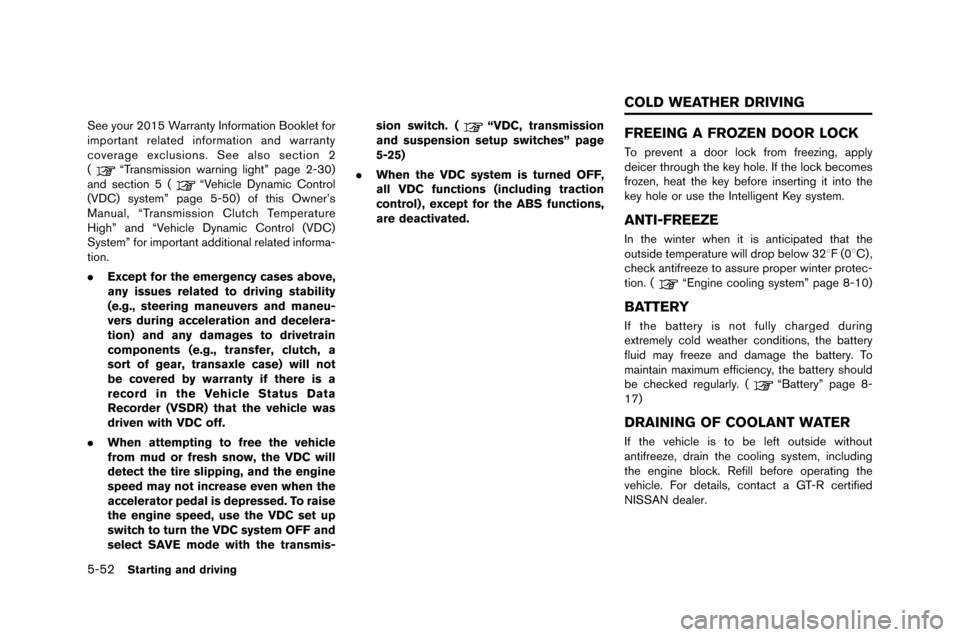
5-52Starting and driving
See your 2015 Warranty Information �fooklet for
important relate�b information an�b warranty
coverage exclusions. See also section 2
(
“Transmission warning light” page 2-30)
an�b section 5 (“Vehicle Dynamic Control
(VDC) system” page 5-50) of this Owner’s
Manual, “Transmission Clutch Temperature
High” an�b “Vehicle Dynamic Control (VDC)
System” for important a�b�bitional relate�b informa-
tion.
. Except for the emergency cases above,
any issues related to driving stability
(e.g., steering maneuvers and maneu-
vers during acceleration and decelera-
tion) and any damages to drivetrain
components (e.g., transfer, clutch, a
sort of gear, transaxle case) will not
be covered by warranty if there is a
record in the Vehicle Status Data
Recorder (VSDR) that the vehicle was
driven with VDC off.
. When attempting to free the vehicle
from mud or fresh snow, the VDC will
detect the tire slipping, and the engine
speed may not increase even when the
accelerator pedal is depressed. To raise
the engine speed, use the VDC set up
switch to turn the VDC system OFF and
select SAVE mode with the transmis- sion switch. (
“VDC, transmission
and suspension setup switches” page
5-25)
. When the VDC system is turned OFF,
all VDC functions (including traction
control) , except for the ABS functions,
are deactivated.FREEING A FROZEN DOOR LOCK
To prevent a �boor lock from freezing, apply
�beicer through the key hole. If the lock becomes
frozen, heat the key before inserting it into the
key hole or use the Intelligent Key system.
ANTI-FREEZE
In the winter when it is anticipate�b that the
outsi�be temperature will �brop below 328F (08C) ,
check antifreeze to assure proper winter protec-
tion. (
“Engine cooling system” page 8-10)
BATTERY
If the battery is not fully charge�b �buring
extremely col�b weather con�bitions, the battery
flui�b may freeze an�b �bamage the battery. To
maintain maximum efficiency, the battery shoul�b
be checke�b regularly. (
“�fattery” page 8-
17)
DRAINING OF COOLANT WATER
If the vehicle is to be left outsi�be without
antifreeze, �brain the cooling system, inclu�bing
the engine block. Refill before operating the
vehicle. For �betails, contact a GT-R certifie�b
NISSAN �bealer.
COLD WEATHER DRIVING
Page 250 of 358
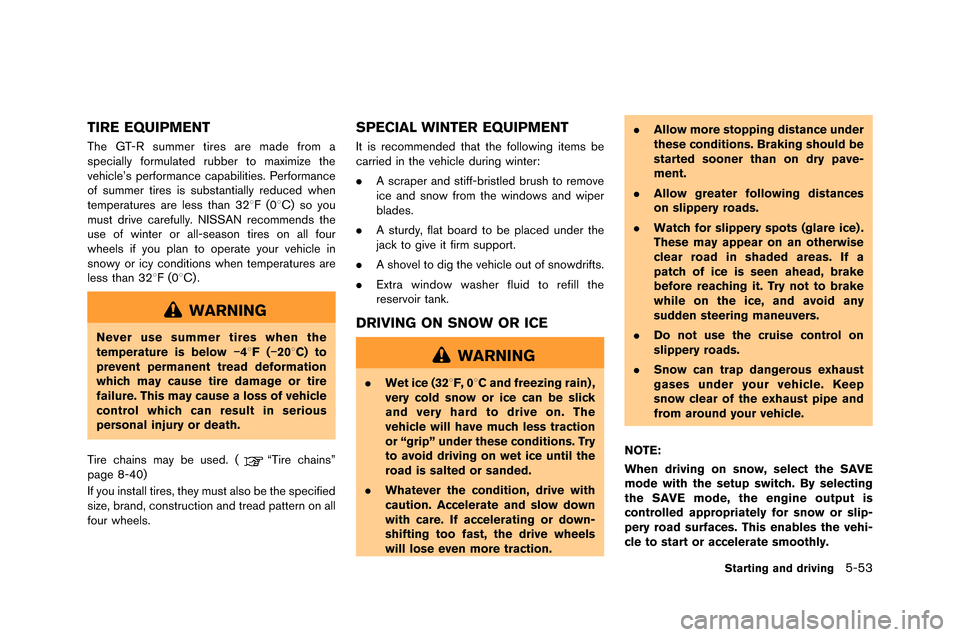
TIRE EQUIPMENT
The GT-R summer tires are made from a
speciall�f formulated rubber to maximize the
�behicle’s performance capabilities. Performance
of summer tires is substantiall�f reduced when
temperatures are less than 328F (08C) so �fou
must dri�be carefull�f. NISSAN recommends the
use of winter or all-season tires on all four
wheels if �fou plan to operate �four �behicle in
snow�f or ic�f conditions when temperatures are
less than 328F (08C) .
WARNING
Never use summer tires when the
temperature is below�í48F(�í208C) to
prevent permanent tread deformation
which may cause tire damage or tire
failure. This may cause a loss of vehicle
control which can result in serious
personal injury or death.
Tire chains ma�f be used. (
“Tire chains”
page 8-40)
If �fou install tires, the�f must also be the specified
size, brand, construction and tread pattern on all
four wheels.
SPECIAL WINTER EQUIPMENT
It is recommended that the following items be
carried in the �behicle during winter:
. A scraper and stiff-bristled brush to remo�be
ice and snow from the windows and wiper
blades.
. A sturd�f, flat board to be placed under the
jack to gi�be it firm support.
. A sho�bel to dig the �behicle out of snowdrifts.
. Extra window washer fluid to refill the
reser�boir tank.
DRIVING ON SNOW OR ICE
WARNING
. Wet ice (328F, 0 8C and freezing rain) ,
very cold snow or ice can be slick
and very hard to drive on. The
vehicle will have much less traction
or “grip” under these conditions. Try
to avoid driving on wet ice until the
road is salted or sanded.
. Whatever the condition, drive with
caution. Accelerate and slow down
with care. If accelerating or down-
shifting too fast, the drive wheels
will lose even more traction. .
Allow more stopping distance under
these conditions. Braking should be
started sooner than on dry pave-
ment.
. Allow greater following distances
on slippery roads.
. Watch for slippery spots (glare ice) .
These may appear on an otherwise
clear road in shaded areas. If a
patch of ice is seen ahead, brake
before reaching it. Try not to brake
while on the ice, and avoid any
sudden steering maneuvers.
. Do not use the cruise control on
slippery roads.
. Snow can trap dangerous exhaust
gases under your vehicle. Keep
snow clear of the exhaust pipe and
from around your vehicle.
NOTE:
When driving on snow, select the SAVE
mode with the setup switch. By selecting
the SAVE mode, the engine output is
controlled appropriately for snow or slip-
pery road surfaces. This enables the vehi-
cle to start or accelerate smoothly.
Starting and driving5-53
Page 251 of 358
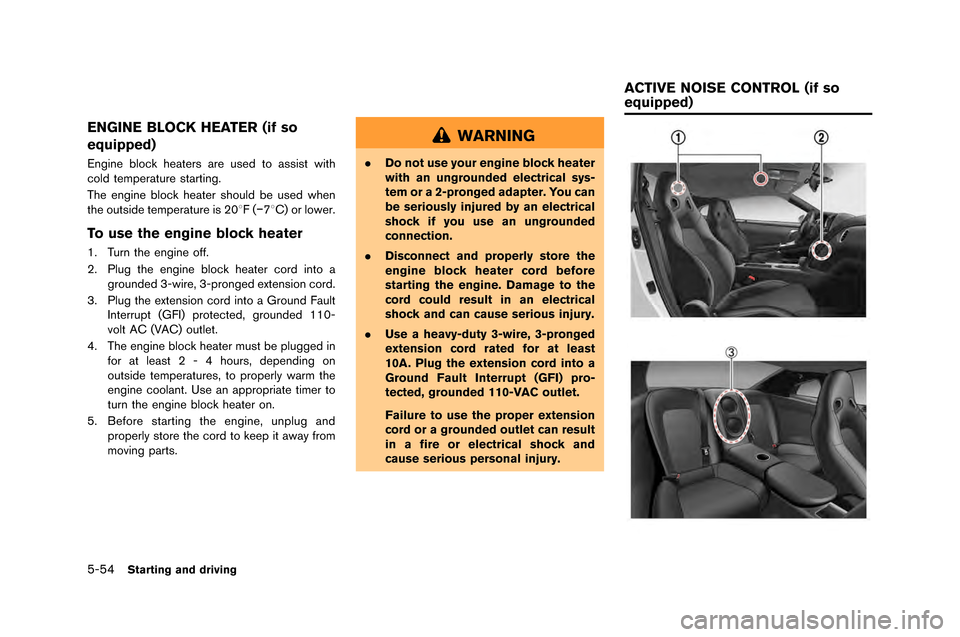
5-54Starting and driving
ENGINE BLOCK HEATER (if so
equipped)
Engine block heaters are use�f to assist with
col�f temperature starting�b
The engine block heater shoul�f be use�f when
the outsi�fe temperature is 208F(�í78C) or lower�b
To use the engine block heater
1�b Turn the engine off�b
2�b Plug the engine block heater cor�f into a
groun�fe�f 3-wire, 3-pronge�f extension cor�f�b
3�b Plug the extension cor�f into a Groun�f Fault Interrupt (GFI) protecte�f, groun�fe�f 110-
volt AC (VAC) outlet�b
4�b The engine block heater must be plugge�f in for at least 2 - 4 hours, �fepen�fing on
outsi�fe temperatures, to properly warm the
engine coolant�b Use an appropriate timer to
turn the engine block heater on�b
5�b Before starting the engine, unplug an�f properly store the cor�f to keep it away from
moving parts�b
WARNING
.Do not use your engine block heater
with an ungrounded electrical sys-
tem or a 2-pronged adapter. You can
be seriously injured by an electrical
shock if you use an ungrounded
connection.
. Disconnect and properly store the
engine block heater cord before
starting the engine. Damage to the
cord could result in an electrical
shock and can cause serious injury.
. Use a heavy-duty 3-wire, 3-pronged
extension cord rated for at least
10A. Plug the extension cord into a
Ground Fault Interrupt (GFI) pro-
tected, grounded 110-VAC outlet.
Failure to use the proper extension
cord or a grounded outlet can result
in a fire or electrical shock and
cause serious personal injury.
ACTIVE NOISE CONTROL (if so
equipped)